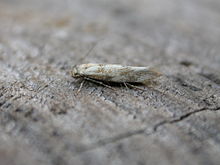Mompha epilobiella
- Machine translation, like DeepL or Google Translate, is a useful starting point for translations, but translators must revise errors as necessary and confirm that the translation is accurate, rather than simply copy-pasting machine-translated text into the English Wikipedia.
- Consider adding a topic to this template: there are already 1,848 articles in the main category, and specifying
|topic=will aid in categorization. - Do not translate text that appears unreliable or low-quality. If possible, verify the text with references provided in the foreign-language article.
- You must provide copyright attribution in the edit summary accompanying your translation by providing an interlanguage link to the source of your translation. A model attribution edit summary is
Content in this edit is translated from the existing German Wikipedia article at [[:de:Mompha epilobiella]]; see its history for attribution. - You may also add the template
{{Translated|de|Mompha epilobiella}}to the talk page. - For more guidance, see Wikipedia:Translation.
| Mompha epilobiella | |
|---|---|
 | |
 | |
| Scientific classification | |
| Domain: | Eukaryota |
| Kingdom: | Animalia |
| Phylum: | Arthropoda |
| Class: | Insecta |
| Order: | Lepidoptera |
| Family: | Momphidae |
| Genus: | Mompha |
| Species: | M. epilobiella |
| Binomial name | |
| Mompha epilobiella | |
| Synonyms | |
| List
| |
Mompha epilobiella is a moth in the family Momphidae found in Europe and North America.
Description
The wingspan is 10–13 mm. Adults are on wing throughout the year, but are most common in July and August in Great Britain.[2]
The larvae have been recorded feeding on rosebay willowherb (Chamerion angustifolium), great willowherb (Epilobium hirsutum), broad-leaved willowherb (Epilobium montanum), marsh willowherb (Epilobium palustre) and evening primrose (Oenothera species), but great willowherb is the main food plant. The other listed plants might be misidentifications. Young larvae probably live as leaf miners. Older larvae live, mostly communally, in spun uppermost leaves.[3]
Distribution
It has a Holarctic distribution, found in North America, including Ontario and all of Europe.
References
- ^ "Mompha (Mompha) epilobiella (Denis & Schiffermüller, 1775)". Fauna europaea. Retrieved 3 May 2020.
- ^ Kimber, Ian. "40.010 BF893 Mompha epilobiella ([Denis & Schiffermüller], 1775)". UKmoths. Retrieved 3 May 2020.
- ^ Ellis, W N. "Mompha epilobiella (Denis & Schiffermüller, 1775) common mompha". Plant Parasites of Europe. Retrieved 3 May 2020.
External links
- Bug Guide


- v
- t
- e











